当前位置:
X-MOL 学术
›
J. Chem. Theory Comput.
›
论文详情
Our official English website, www.x-mol.net, welcomes your
feedback! (Note: you will need to create a separate account there.)
Polarizable Density Embedding Coupled Cluster Method
Journal of Chemical Theory and Computation ( IF 5.7 ) Pub Date : 2018-02-14 00:00:00 , DOI: 10.1021/acs.jctc.7b01153 Dalibor Hršak 1 , Jógvan Magnus Haugaard Olsen 1 , Jacob Kongsted 1
Journal of Chemical Theory and Computation ( IF 5.7 ) Pub Date : 2018-02-14 00:00:00 , DOI: 10.1021/acs.jctc.7b01153 Dalibor Hršak 1 , Jógvan Magnus Haugaard Olsen 1 , Jacob Kongsted 1
Affiliation

|
We present the theory and implementation of the polarizable density embedding (PDE) model in combination with coupled cluster (CC) theory (PDE-CC). This model has been implemented in the Dalton quantum chemistry program by adapting the CC code to the polarizable embedding library (PElib). In the PDE-CC method, the smaller, but chemically important core region is described with a high-level CC method. The environment surrounding the core region can be separated into two levels of description: an inner and an outer region. The effect of the inner region on the core region is described by an embedding potential consisting of a set of fragment densities obtained from calculations on isolated fragments with a quantum-chemistry method such as Hartree–Fock (HF) or Kohn–Sham density functional theory (KS-DFT) and dressed with a set of atom-centered anisotropic dipole–dipole polarizabilities. The outer region consists of distributed atom-centered multipoles and polarizabilities, i.e., in the same way as in the polarizable embedding (PE) model. The PDE-CC method contains embedding potential operators that account for the electrostatic and polarization interactions between the core region and the environment, as well as for nonelectrostatic (also known as Pauli and exchange) repulsion. All environmental effects are included through one-electron operators and account very efficiently for the response of the environment due to the change in the electron density of the core region, e.g., upon an electronic transition.
中文翻译:

极化密度嵌入耦合簇方法
我们结合耦合簇(CC)理论(PDE-CC)提出了可极化密度嵌入(PDE)模型的理论和实现。该模型已在Dalton量子化学程序中实现,方法是将CC代码改编为可极化的嵌入库(PElib)。在PDE-CC方法中,使用高级CC方法描述了较小但化学上重要的核心区域。围绕核心区域的环境可以分为两个层次的描述:内部区域和外部区域。内部区域对核心区域的影响通过嵌入电位来描述,该电位由一组碎片密度组成,这些碎片密度是通过使用量子化学方法(例如Hartree-Fock(HF)或Kohn-Sham密度泛函理论)对孤立的碎片进行计算而获得的(KS-DFT)并具有一组以原子为中心的各向异性偶极-偶极极化率。外部区域由分布的以原子为中心的多极和极化率组成,即,与可极化嵌入(PE)模型中的方式相同。PDE-CC方法包含嵌入电势算子,这些算子说明了核心区域与环境之间的静电和极化相互作用以及非静电(也称为Pauli和交换)排斥。所有环境效应都通过单电子算子包括在内,并且非常有效地说明了由于核心区域电子密度的变化(例如,在电子跃迁时)而引起的环境响应。
更新日期:2018-02-14
中文翻译:

极化密度嵌入耦合簇方法
我们结合耦合簇(CC)理论(PDE-CC)提出了可极化密度嵌入(PDE)模型的理论和实现。该模型已在Dalton量子化学程序中实现,方法是将CC代码改编为可极化的嵌入库(PElib)。在PDE-CC方法中,使用高级CC方法描述了较小但化学上重要的核心区域。围绕核心区域的环境可以分为两个层次的描述:内部区域和外部区域。内部区域对核心区域的影响通过嵌入电位来描述,该电位由一组碎片密度组成,这些碎片密度是通过使用量子化学方法(例如Hartree-Fock(HF)或Kohn-Sham密度泛函理论)对孤立的碎片进行计算而获得的(KS-DFT)并具有一组以原子为中心的各向异性偶极-偶极极化率。外部区域由分布的以原子为中心的多极和极化率组成,即,与可极化嵌入(PE)模型中的方式相同。PDE-CC方法包含嵌入电势算子,这些算子说明了核心区域与环境之间的静电和极化相互作用以及非静电(也称为Pauli和交换)排斥。所有环境效应都通过单电子算子包括在内,并且非常有效地说明了由于核心区域电子密度的变化(例如,在电子跃迁时)而引起的环境响应。











































 京公网安备 11010802027423号
京公网安备 11010802027423号